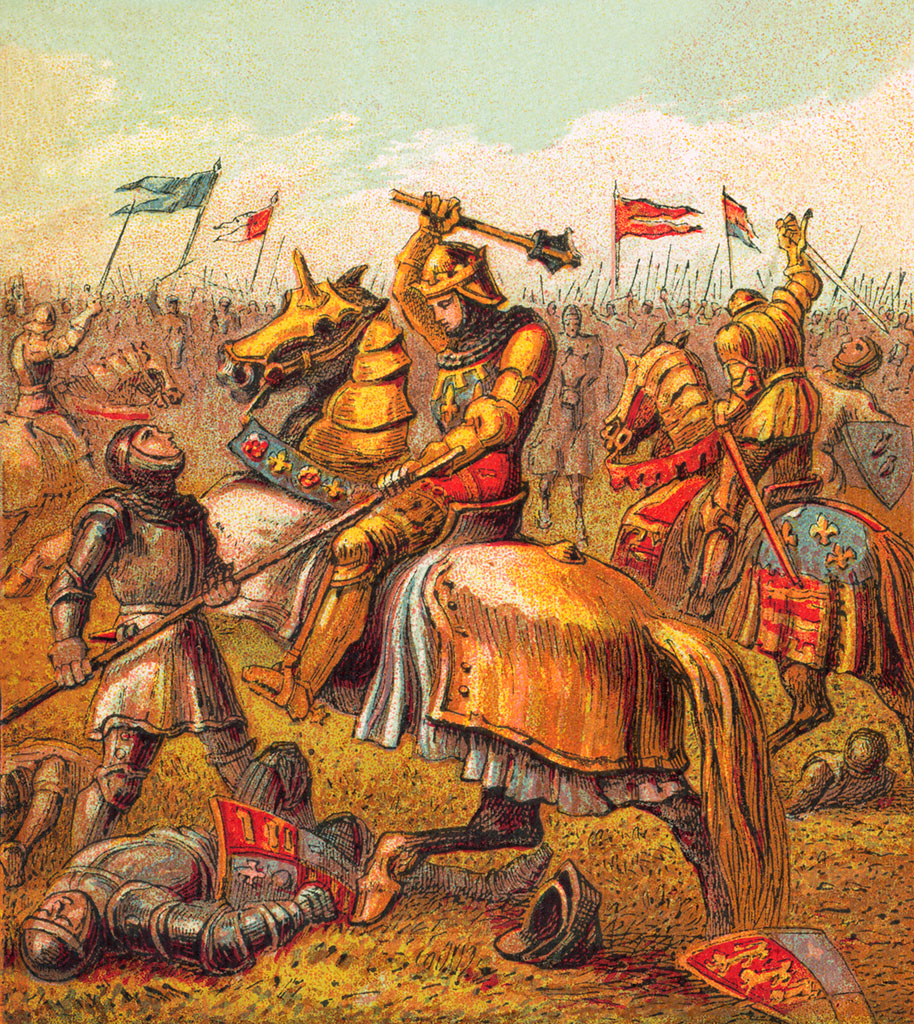The series of civil battles fought between the House of Lancaster and the House of York from 1455 to 1471 have been named the Wars of the Roses because the House of York was emblematized by a white rose and the House of Lancaster by a red rose.
When the Tudor dynasty came to power it merged the two roses, symbolizing the union of the two factions. Since Henry VII from the House of Tudor came out of those battles the ultimate winner, the end of the Wars of the Roses has often been dated to 1485.
During the long reign of the Lancastrian king Henry VI (1422–61), the power and dignity of the English monarchy sank rapidly as a result of the king’s questionable mental capacity and lack of political and military skills.
  |
The decline of royal authority encouraged factious contentions among great noblemen of the court and broke down social order all over the countryside, where uniformed retainers of noblemen inflicted intimidation, injustice, and even regional warfare upon the people. Contemporaries referred to such disorderly conduct and senseless violence as “livery and maintenance.”
The first war broke out in May 22, 1455, when Richard, duke of York, supported by Richard Neville, earl of Salisbury and of Warwick, intercepted the Lancastrian court of Henry VI in St. Albans and fought a half-hour battle there, defeating the Lancastrian army and killing their commander, Edmund Beaufort, duke of Somerset.
The Yorkist victory intensified the battle between the House of York and Queen Margaret, who was forced to lead the Lancastrians during the periodic insanity of her husband. Whenever Richard made attempts to assume the protectorate during the king’s temporary sickness, the queen fought back. She subsequently succeeded in winning the court battles, forcing leading Yorkists into exile in 1459.
The crisis renewed in 1460, when the Yorkists returned and defeated the Lancastrians at the Battle of Northampton in July, capturing the king and forcing him to accept a humiliating compromise, which allowed the king to remain in power for life and made the duke of York and his heirs the successors to the throne.
 |
| Battle in Towton, March 1461 |
In December, Queen Margaret organized a successful counterattack at the Battle of Wakefield to rescue the hereditary right to the throne for her son, Prince Edward. Richard, duke of York, died in the battle, and his son Edward assumed the Yorkist leadership. The power struggle at the court became an open war for the Crown between the two houses. Both could trace their ancestry to Edward III (1327–77), but neither had a flawless claim.
In 1461, two battles were fought, first at Mortimer’s Cross, and then at Towton, which resulted in the end of the 62 years of Lancastrian rule. Henry VI was exiled to Scotland with his wife and son. Edward IV became the first Yorkist king.
The war continued, however, because of the weak hereditary claim of the House of York, and the nobility became even more divided when private interests and mutual hatred drove them constantly to change allegiances. In 1464 Edward IV alienated the earl of Warwick, who had helped the king win his throne and supported the king in his early years, and thus became known as the kingmaker.
   |
In 1469, the earl formed an alliance with the exiled Lancastrian queen Margaret. Together, they helped Henry VI take back London and regain the Crown in 1470. The recovery of the Lancastrian power, however, lasted only about six months.
In 1471, Edward IV defeated the Lancastrians and killed the earl at the Battle of Barnet in April and won the Battle of Tewkesbury in early May, capturing Henry VI and his queen and killing Prince Edward on the battlefield.
However, after the crushing of the House of Lancaster, the Yorkists did not hold onto the Crown long. Between 1483 and 1485, the sudden death of Edward IV was followed by the usurpation of the Crown by Richard III over his uncrowned nephew Edward V. These events opened a new phase of dynastic contention.
Henry Tudor, with a very weak hereditary claim to the English throne, took the opportunity and fought on behalf of the Lancastrians against the unpopular usurper, Richard III. In 1485, the right to the English Crown was finally decided at the Battle of Bosworth, in which Henry killed Richard, dispersed the Yorkist army, and made himself Henry VII, the first Tudor king.
The Wars of the Roses left a ravaged nation to Henry VII, who was facing troubles similar to what his Lancastrian and Yorkist predecessors had suffered for the past three decades. The legitimacy of the Crown was challengeable. The great noble houses remained divided among themselves and defiant of the central authority.
The old administrative mechanism no longer functioned and parliamentary institutions, the king, and the two houses did not know how to work together. The transformation of an agrarian economy to a mixed one with trade and commerce was well under way, social and religious crises were on the horizon, and the royal treasury was empty.
